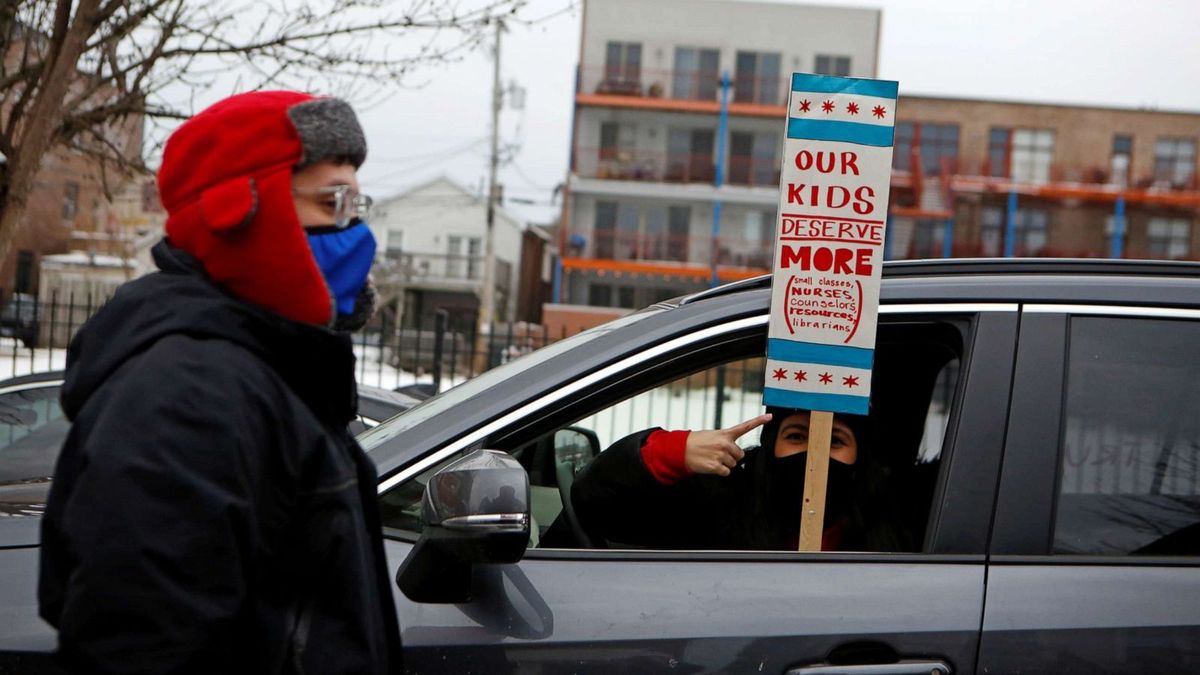Why are teachers from big cities threatening to strike?

A few minutes every morning is all you need.
Stay up to date on the world's Headlines and Human Stories. It's fun, it's factual, it's fluff-free.
With COVID-19 still running rampant throughout the US, many teachers, especially in big cities, refuse to work in conditions that may put them at risk.
Though much of the country has already reopened schools for in-person learning in some form, many schools have remained online. School closures have added stress to the everyday lives of people, directly and indirectly, with special-education students and students with accommodations being among the most negatively affected.
Schools also provide 20.1 million free lunches daily to students who may not have another meal. Now that many schools are no longer meeting in person, many students will go hungry.
With these issues in mind, one of President Biden’s goals in his first 100 days was to reopen schools safely. But with COVID-19 still running rampant throughout the United States, many teachers, especially in big cities, refuse to work in conditions that may put them at risk.
Vaccine priority
Many teachers don’t want to move to in-person teaching without first being vaccinated. However, most teachers remain unvaccinated despite early calls by the Centers for Disease Control and Prevention (CDC) for teachers to be prioritized.
When the Food and Drug Administration (FDA) approved vaccines from Moderna and Pfizer for public use, the CDC declared that “people who work in educational settings” are at “increased risk of acquiring or transmitting COVID-19.” Teachers were categorized in Phase 1b, one step behind people working in hospitals.
Since the initial announcement by the CDC, however, clarifications have been issued. “I also want to be clear that there is increasing data to suggest that schools can safely reopen,” CDC Director Rochelle Walensky told reporters at a press briefing. “And that safe reopening does not suggest that teachers need to be vaccinated in order to reopen safely.”
In a survey released by the National Education Association (NEA), only one in five NEA members had been vaccinated so far, around 18%. Additionally, the survey found that only an additional 17% have scheduled their vaccines. Despite being so high on the priority list, many other teachers are still uncertain when they will receive a vaccine and, as a result, are hesitant about returning to an environment that may see themselves and their students put at greater risk.
Teachers remain unconvinced of safety
Though the CDC has offered guidelines detailing how to properly open schools to physical, in-person learning, concerns over whether these guidelines are being taken seriously remain strong among teachers and some parents.
“Those CDC standards still aren’t being met,” says NEA President Beckey Pringle. “Most schools, especially those attended by Black, brown, Indigenous, and poor white students have severely outdated ventilation systems and no testing or tracing programs to speak of.”
In higher-education facilities, where students are tested at higher rates, The New York Times reported in 2020 that there were over 397,000 cases with at least 90 deaths on campus. Only four of the deaths were students. The rest were college employees.
In Chicago, a contentious fight between the Chicago Public School board of education (CPS) and the Chicago Teachers Union (CTU) took place over the safety of returning to in-person learning.
In what was referred to as a “hostage takeover of our children,” by Alderman Walter Burnett Jr., the CTU gave its own framework to the CPS. These included additional school safety measures, vaccines, and remote-work accommodations for CPS staff.
Though the reopening of these schools brought joy to many students and parents, teachers remain cautiously optimistic about their union’s plans.
“I think the real test of whether or not CTU was successful in negotiating a better plan is going to be whether or not we see more (students) return,” James Klock, a teacher at Benito Juarez Community Academy in Pilsen, told The Chicago Tribune. “Now the safety committees, the mechanism by which this agreement is to be upheld … need to form immediately and start working to share power between administrators and educators.”
Teachers in Washington, DC also anxiously returned to in-person schooling at the beginning of February after having been closed since December. Students were not required to physically attend classes, so most schools only saw a handful of students show up for each class.
This comes on the back of the Washington Teachers Union (WTU) filing a complaint against Washington, DC public schools for violating safety protocols after the death of Helen White due to COVID-19 on January 11. WTU President Elizabeth Davis says the school did not inform White’s students or make public her illness until 11 days after the fact. Additionally, the union argued District of Columbia Public Schools (DCPS) violated its contractual obligation of keeping the school environment “free of hazards” to union members.
Though the WTU does not fully agree with returning to in-person learning, Davis urged teachers to return to schools as it is illegal for government employees in Washington, DC to strike.
“Teachers want to go back to in-school learning when they are assured the buildings are safe,” Davis said in a press release. “We are not trying to stand in the way of reopening. We are mirroring the fear we’re hearing in communities … We hope we can work with the mayor and chancellor and get educators and DCPS students back to safe and healthy schools without a strike. A strike will always be the last resort, and we hope it doesn’t come to that.”
Have a tip or story? Get in touch with our reporters at tips@themilsource.com




Comments ()